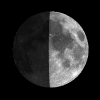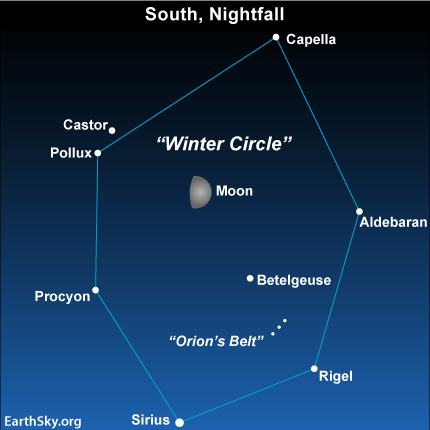Courtesy of EarthSky
A Clear Voice for Science
Visit EarthSky at
www.EarthSky.org

 As seen tonight from all over the world, the moon passes right in front of the great big loop of stars known to northern hemisphere residents as the Winter Circle or the Winter Hexagon. This huge star formation makes even the constellation Orion the Hunter look small. Orion sits in the southwest (lower right) corner of the Winter Circle.
As seen tonight from all over the world, the moon passes right in front of the great big loop of stars known to northern hemisphere residents as the Winter Circle or the Winter Hexagon. This huge star formation makes even the constellation Orion the Hunter look small. Orion sits in the southwest (lower right) corner of the Winter Circle.
The Winter Circle is an asterism – a group of stars that is NOT a constellation. Its northernmost star is Capella, the brightest in the constellation Auriga the Charioteer. The southernmost star is Sirius, the Dog Star – the brightest of all stars to light up Earth’s nighttime sky. Can you connect all the “dots” – that is, stars – to find the Winter Circle’s place in the starry heavens?
More on the Winter Circle: Winter’s brightest stars
As seen from mid-northern latitudes at dusk and nightfall, the moon and Capella beam high overhead, while Sirius shines farthest down, rather close to the southern horizon. However, as seen from mid-southern latitudes – like those in Australia – Sirius stands at the top of the Winter Circle, and Capella marks the bottom, lurking close to the northern horizon.
Whether you live in the northern hemisphere or the southern hemisphere, let the moon be your guide to the Winter Circle this Sunday evening.
Capella, the stellar beacon of Auriga
Astronomy Picture of the Day from NASA/JPL
U.S. Naval Observator Astronomical Information center
The York County Astronomical Society